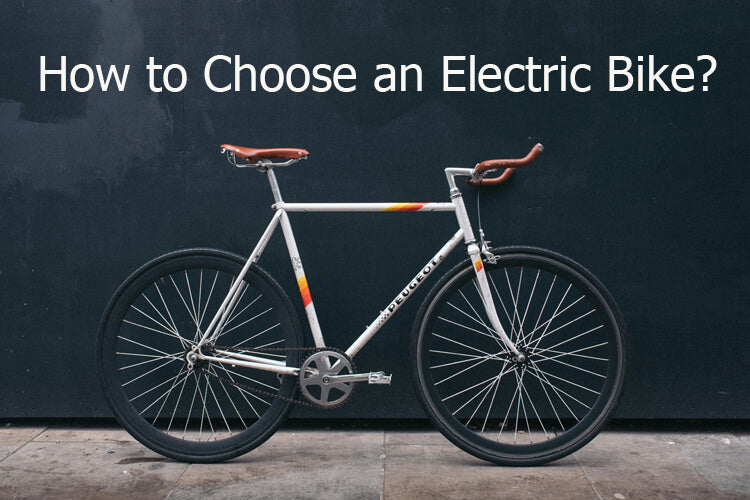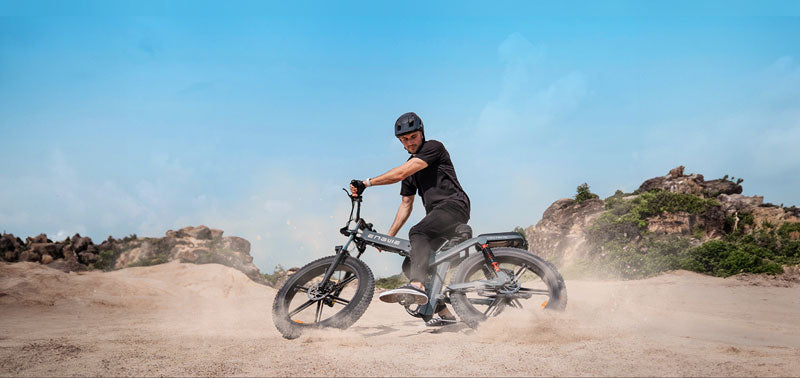The transportation landscape is undergoing an electric revolution, and e-bikes are at the forefront. Once a niche product, electric bicycles (e-bikes) are now experiencing a boom and surge in popularity. This is not surprising, as electric bikes offer a compelling combination of advantages. It's ideal for your daily commute, exploring scenic trails, or simply enjoying a leisurely ride. So, how to choose an electric bike that suits you? This article will tell you 7 main factors that you should consider when choosing the right electric bike.

Factor 1: Understanding E-Bike Laws (Know the Rules of the Ride)
Before diving into the exciting world of e-bike selection, it's crucial to understand the legalities surrounding their operation. E-bike classifications play a vital role in determining where you can ride and how your e-bike functions. Here, we'll take a specific look at California's e-bike classifications, which is a valuable reference for how to choose an e-bike.
There are three main types of e-bikes in California, each with different characteristics:
| E-bike Classifications | Class 1 E-Bikes | Class 2 E-Bikes | Class 3 E-Bikes |
|---|---|---|---|
| Speed Limit | These are considered the most bicycle-like e-bikes. They feature a motor that assists pedaling up to 20 mph (32 km/h). | Offering a bit more power, Class 2 e-bikes also provide pedal-assist up to 20 mph (32 km/h). | These are the most powerful category of e-bikes allowed in California. Class 3 e-bikes offer pedal-assist up to 28 mph (45 km/h). |
| Rode Limit | Class 1 e-bikes are treated the same way as traditional bicycles under California law. This means you can ride them on bike paths, lanes, and roads. | Similar to Class 1 e-bikes, Class 2 e-bikes can be ridden on bike paths, lanes, and roads, adhering to all traffic regulations. | Due to their higher speed capabilities, California law restricts Class 3 e-bikes from most bike paths and shared-use trails. |
| Age Limit | There's no minimum age requirement for Class 1 e-bikes, but all riders under 18 must wear a properly fitted helmet. | The minimum age requirement for Class 2 e-bikes is 16 years old, and all riders under 18 must wear a helmet. | The minimum age requirement for Class 3 e-bikes is 16 years old, and all riders must wear a helmet. |
Factor 2: Deciding Your E-Bike Needs
Now that you've grasped the legalities surrounding e-bikes, it's time to delve into the exciting world of choosing the perfect one for you! This section focuses on two key factors that will significantly influence your decision: terrain and usage.
1. Considering Your Usage
- Conquering the Commute: If your primary goal is an eco-friendly and sweat-minimizing commute, prioritize features that enhance comfort and efficiency. Look for an e-bike with a comfortable upright riding position, a reliable motor for tackling moderate hills, and a long battery range to ensure you reach your destination without needing a mid-commute recharge. Engwe's electric commuter bikes can basically meet these needs, and the price is very affordable, you can consider them.
- Exercise on Two Wheels: If you're looking to combine exercise with your daily dose of fresh air, consider a hybrid approach. E-bikes with adjustable assist levels allow you to tailor your workout - you can choose between a high-assist mode for cruising and a lower-assist mode for a more challenging ride.
- Convenience in Carrying Items: If you have the need to carry groceries or other necessities, then you should prioritize a bike with a sturdy frame, racks, and baskets that can bring you convenience.
2. Thinking About Terrain
- Flat Roads and City Cruising: For flat terrain and leisurely rides, a lower-powered motor (around 250 watts) is sufficient. These e-bikes are typically lighter and easier to maneuver in crowded city streets.
- Hilly Commutes and Moderate Off-Road: If your commute or preferred riding routes involve some hills, opt for a motor with more power (around 350-500 watts) to tackle inclines with ease.
- Off-Road Adventures: For serious off-road adventures, a high-powered motor (750 watts or higher) will provide the necessary grunt to conquer challenging terrain. Full-suspension e-bikes offer superior comfort and control on rough trails.

Tips: There are some e-bikes equipped with extra-wide fat tires that can handle almost any terrain, making them the perfect adventure companion. If you are interested in this kind of electric bikes, you can check out Engwe's Fat Tire Electric Bikes.
Factor 3: Key E-Bike Components
Now let's delve into the key components that make these electric wonders work. Understanding these components will allow you to make an informed choice when choosing the perfect electric bike.
1. Motor (The Heart of the E-Bike)
The motor is the heart of an e-bike, providing the electric assist that propels you forward. When considering motors, two key factors come into play:
1) Wattage: Motors are measured in watts, which represents the motor's power output.
2) Motor Type: There are two main types of e-bike motors: mid-drive and hub motors.
- Mid-Drive Motors: These motors are positioned near the pedals, integrating with the drive train.
- Hub Motors: These motors are located within the front or rear wheel hub. Hub motors are generally more affordable and simpler in design.
2. Battery (The Power Source)
The battery is the lifeblood of your e-bike, storing the energy that powers the motor.
1) Battery Capacity: Battery capacity is measured in watt hours (Wh) and represents the amount of energy the battery can store.
2) Range: The range of an e-bike depends on factors such as terrain, motor usage and rider weight. At the same time, the battery is also an important factor. The capacity of the battery determines the cruising range to a large extent. Generally speaking, the driving range on a single charge is 20 to 80 miles.
3. Brakes (Stopping Power Matters)
Reliable brakes are crucial for safe e-bike riding. There are two main types of e-bikes brakes:
1) Hydraulic Disc Brakes: These brakes offer superior stopping power in all weather conditions. They require minimal hand effort and provide excellent control.
2) Mechanical Disc Brakes: While less powerful than hydraulic disc brakes, they offer good stopping power and are generally more affordable.

Factor 4: Budget and Warranty
Before choosing an e-bike, set a realistic budget. Because the price of electric bicycles varies, it mainly depends on factors such as motor power, battery capacity and brand. At the same time, you also have to consider the cost of accessories like helmets, locks, and mudguards. Additionally, consider warranty options offered by different manufacturers. A longer warranty provides peace of mind and protects you against unforeseen repairs.
Factor 5: Comfort is King (or Queen)
An e-bike ride should be a joyride, not a backache-inducing experience. And if you want to have a pleasant riding experience, you should pay attention to the comfort and ergonomic design of the e-bike when choosing. You can look for the following features:
- Adjustable Seat: A seat that adjusts to your height is crucial for maintaining proper leg extension while pedaling.
- Handlebar Options: Some e-bikes offer handlebar options like upright handlebars for a more relaxed riding position or swept-back handlebars for a more aerodynamic posture.
- Frame Size: Choose a frame size that fits your height comfortably. A good e-bike shop will help you determine the best fit.
Factor 6: Safety First
Safety should always be your top priority while riding an e-bike. Here are some essential e-bike safety tips to remember:
- Always wear a properly fitted helmet: Look for a helmet specifically designed for e-bikes, which may offer additional protection compared to traditional bicycle helmets.
- Invest in good quality lights: Ensure your e-bike has a bright white headlight and a red taillight for increased visibility during low-light conditions. In addition, consider adding reflective gear to your clothing and bike for extra visibility.
- Follow the rules of the road: E-bikes are classified as bicycles in most areas, so adhere to all traffic regulations.
- Be aware of your surroundings: Ride defensively and avoid distractions like using your phone while riding.
Factor 7: Test Ride and Purchase - Taking the Wheel of Your E-Bike Dream
You've navigated the exciting world of e-bike knowledge, pinpointing your needs and the key components that make these electric marvels tick. Now it's time for the moment you've been waiting for: taking your dream e-bike for a spin!
1. The Power of a Test Ride
Before you commit to purchasing an e-bike, a test ride is absolutely essential. Here's why:
- Feel the Difference: E-bikes come in all shapes and sizes, with varying motor power, battery range, and comfort features. A test ride allows you to experience these differences firsthand, ensuring you choose an e-bike that feels comfortable and enjoyable to ride.
- Terrain Trial: Bring your intended riding terrain to mind during your test ride. If you plan to conquer hills, tackle off-road trails, or navigate city streets, ensure the e-bike can handle the job with ease.
- Listen to Your Body: Pay attention to your body's feedback during the test ride. Is the seat comfortable? Does the handlebar position offer optimal control? A test ride helps you identify any potential ergonomic issues before you buy.
2. Negotiating and Finalizing the Purchase
Once you've found the e-bike that steals your heart (and conquers your test ride!), it's time to discuss the purchase. Here are some tips for a smooth transaction:
- Be Prepared: Research the typical price range for the e-bike you're interested in. This empowers you to negotiate effectively.
- Don't Be Afraid to Ask: Inquire about financing options, accessory packages, and any ongoing maintenance requirements.
- Finalize with Confidence: A reputable e-bike shop will prioritize customer satisfaction. If you feel pressured or unsure, take some time to reflect before finalizing the purchase.
Final Thoughts
Choosing the right e-bike is an exciting journey! By considering your needs, preferred riding style, and the key components discussed in this guide, you'll be well-equipped to find the perfect electric companion. Remember, comfort, safety, and budget are also crucial factors. This guide on 'how to choose an electric bike' has equipped you with the knowledge to navigate the exciting world of electric bikes and choose the perfect one for your needs. Follow it and choose an e-bike that's right for you!
It is possible that you also want to know:
Unveiling the Speed: How Fast Do Electric Bikes Go?
Deciphering E-Bikes' Appeal: How Do Electric Bikes Work
Why are E-bikes so Expensive Today? Reasons are Here!